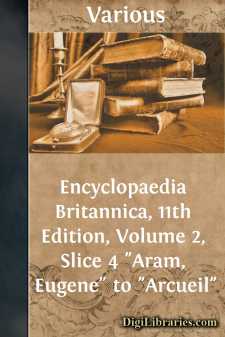Categories
- Antiques & Collectibles 13
- Architecture 36
- Art 48
- Bibles 22
- Biography & Autobiography 813
- Body, Mind & Spirit 142
- Business & Economics 28
- Children's Books 16
- Children's Fiction 13
- Computers 4
- Cooking 94
- Crafts & Hobbies 4
- Drama 346
- Education 46
- Family & Relationships 57
- Fiction 11829
- Games 19
- Gardening 17
- Health & Fitness 34
- History 1377
- House & Home 1
- Humor 147
- Juvenile Fiction 1873
- Juvenile Nonfiction 202
- Language Arts & Disciplines 88
- Law 16
- Literary Collections 686
- Literary Criticism 179
- Mathematics 13
- Medical 41
- Music 40
- Nature 179
- Non-Classifiable 1768
- Performing Arts 7
- Periodicals 1453
- Philosophy 64
- Photography 2
- Poetry 896
- Political Science 203
- Psychology 42
- Reference 154
- Religion 513
- Science 126
- Self-Help 84
- Social Science 81
- Sports & Recreation 34
- Study Aids 3
- Technology & Engineering 59
- Transportation 23
- Travel 463
- True Crime 29
Encyclopaedia Britannica, 11th Edition, Volume 2, Slice 4 "Aram, Eugene" to "Arcueil"
by: Various
Publisher:
DigiLibraries.com
ISBN:
N/A
Language:
English
Published:
1 year ago
Downloads:
13
Categories:
*You are licensed to use downloaded books strictly for personal use. Duplication of the material is prohibited unless you have received explicit permission from the author or publisher. You may not plagiarize, redistribute, translate, host on other websites, or sell the downloaded content.
Description:
Excerpt
ARAM, EUGENE(1704-1759), English scholar, but more famous as the murderer celebrated by Hood in his ballad, theDream of Eugene Aram, and by Bulwer Lytton in his romance ofEugene Aram, was born of humble parents at Ramsgill, Yorkshire, in 1704. He received little education at school, but manifested an intense desire for learning. While still young, he married and settled as a schoolmaster at Netherdale, and during the years he spent there, he taught himself both Latin and Greek. In 1734 he removed to Knaresborough, where he remained as schoolmaster till 1745. In that year a man named Daniel Clark, an intimate friend of Aram, after obtaining a considerable quantity of goods from some of the tradesmen in the town, suddenly disappeared. Suspicions of being concerned in this swindling transaction fell upon Aram. His garden was searched, and some of the goods found there. As, however, there was not evidence sufficient to convict him of any crime, he was discharged, and soon after set out for London, leaving his wife behind. For several years he travelled through parts of England, acting as usher in a number of schools, and settled finally at Lynn, in Norfolk. During his travels he had amassed considerable materials for a work he had projected on etymology, to be entitled aComparative Lexicon of the English, Latin, Greek, Hebrew and Celtic Languages. He was undoubtedly an original philologist, who realized, what was then not yet admitted by scholars, the affinity of the Celtic language to the other languages of Europe, and could dispute the then accepted belief that Latin was derived from Greek. Aram’s writings show that he had grasped the right idea on the subject of the Indo-European character of the Celtic language, which was not established till J.C. Prichard published his book,Eastern Origin of the Celtic Nations, in 1831. But he was not destined to live in history as the pioneer of a new philology. In February 1758 a skeleton was dug up at Knaresborough, and some suspicion arose that it might be Clark’s. Aram’s wife had more than once hinted that her husband and a man named Houseman knew the secret of Clark’s disappearance. Houseman was at once arrested and confronted with the bones that had been found. He affirmed his innocence, and, taking up one of the bones, said, “This is no more Dan Clark’s bone than it is mine.” His manner in saying this roused suspicion that he knew more of Clark’s disappearance than he was willing to admit. He was again examined, and confessed that he had been present at the murder of Clark by Aram and another man, Terry, of whom nothing further is heard. He also gave information as to the place where the body had been buried in St Robert’s Cave, a well-known spot near Knaresborough. A skeleton was dug up here, and Aram was immediately arrested, and sent to York for trial. Houseman was admitted as evidence against him. Aram conducted his own defence, and did not attempt to overthrow Houseman’s evidence, although there were some discrepancies in that; but made a skilful attack on the fallibility of circumstantial evidence in general, and particularly of evidence drawn from the discovery of bones....











